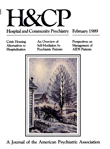Characteristics of Community Support Program Clients in 1980 and 1984
Abstract
Results from a survey of 1,053 clients enrolled in the community support program in 1984 were compared with data on 1,471 clients enrolled in 1980. In 1984 the percentages of males and blacks treated was larger than in 1980, and clients made increased use of private homes and apartments and relied less on supported living arrangements. Both the percentage of clients receiving federal income supports and clients' median income as a percentage of the national median declined between 1980 and 1984. Fewer clients with schizophrenia and more clients with affective disorders were treated in 1984 than in 1980, probably due to implementation of DSM-III. Nationwide, the number of clients in the program grew from 4,288 in 1980 to more than 350,000 in 1984. The preponderance of schizophrenia, unemployment, and history of hospitalization in the 1984 cohort suggests the program is meeting its goal of treating the most severely mentally disabled.
Access content
To read the fulltext, please use one of the options below to sign in or purchase access.- Personal login
- Institutional Login
- Sign in via OpenAthens
- Register for access
-
Please login/register if you wish to pair your device and check access availability.
Not a subscriber?
PsychiatryOnline subscription options offer access to the DSM-5 library, books, journals, CME, and patient resources. This all-in-one virtual library provides psychiatrists and mental health professionals with key resources for diagnosis, treatment, research, and professional development.
Need more help? PsychiatryOnline Customer Service may be reached by emailing [email protected] or by calling 800-368-5777 (in the U.S.) or 703-907-7322 (outside the U.S.).



